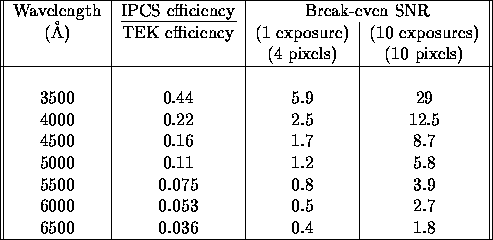 .
As far as signal to noise ratio is concerned, it can be seen from Equation 6.1
that the most effective detector for sky limited observations
is simply the most efficient. For all optical wavelengths this will be the
Tektronix CCD.
.
As far as signal to noise ratio is concerned, it can be seen from Equation 6.1
that the most effective detector for sky limited observations
is simply the most efficient. For all optical wavelengths this will be the
Tektronix CCD.




In order to show how the principles outlined above work out in practice, we concentrate on the comparison between spectroscopy with the IPCS and with the TEK-1024. The ideas discussed in this section can be extended to other detectors. In particular, the high efficiency of the CCD make it clearly the best detector for most imaging applications, but its finite readout noise means that it may be unsuitable for high dispersion spectroscopy.
A first relatively straightforward but important case to deal
with is where the noise level is dominated by the shot noise of the
sky background (sky limited observations). This is usually
the case for low resolution spectroscopy or imaging observations.
Typical values for the sky brightness on La Palma in a variety
of wavebands are given in Section  .
As far as signal to noise ratio is concerned, it can be seen from Equation 6.1
that the most effective detector for sky limited observations
is simply the most efficient. For all optical wavelengths this will be the
Tektronix CCD.
.
As far as signal to noise ratio is concerned, it can be seen from Equation 6.1
that the most effective detector for sky limited observations
is simply the most efficient. For all optical wavelengths this will be the
Tektronix CCD.
We now consider the case where the sky background can be neglected, normally the case for high resolution spectroscopy. As we noted above, observations at high signal levels, where we might expect a high signal to noise ratio, will be best suited for the CCD, whereas observations at very low signal levels, and very low signal to noise ratio, will be best suited for the IPCS. It is interesting to define a break-even signal to noise ratio, equal to the signal to noise ratio which can be reached with the two detectors in the same integration time. Only if the signal-to-noise ratio you require or expect is less than the break-even value will the IPCS acquire it faster.
This is a particularly useful parameter since it is independent of
the observed count rate and hence independent of the object being
observed and the spectrograph configuration. However, the break-even SNR does
depend on the effective CCD readout noise per resolution element
and hence on the number of separate exposures required.
Table  tabulates the break-even signal to noise ratio in
two extreme cases; 1 CCD exposure
with a resolution element of 4 pixels, and 10 exposures with a resolution
element of 10 pixels. Given that exposures of at least half an hour are
standard on the Tektronix CCDs, it is clear from table
tabulates the break-even signal to noise ratio in
two extreme cases; 1 CCD exposure
with a resolution element of 4 pixels, and 10 exposures with a resolution
element of 10 pixels. Given that exposures of at least half an hour are
standard on the Tektronix CCDs, it is clear from table  that
only in the case of very long exposures for low expected signal-to-noise
will the IPCS be the preferred detector, and it will never be the preferred
detector for useful exposures at wavelengths longer than 5000 Å.
that
only in the case of very long exposures for low expected signal-to-noise
will the IPCS be the preferred detector, and it will never be the preferred
detector for useful exposures at wavelengths longer than 5000 Å.

Table: Break-even signal to noise ratio
There are a number of factors in addition to the required signal to noise ratio which need to be taken into account when choosing a detector:



